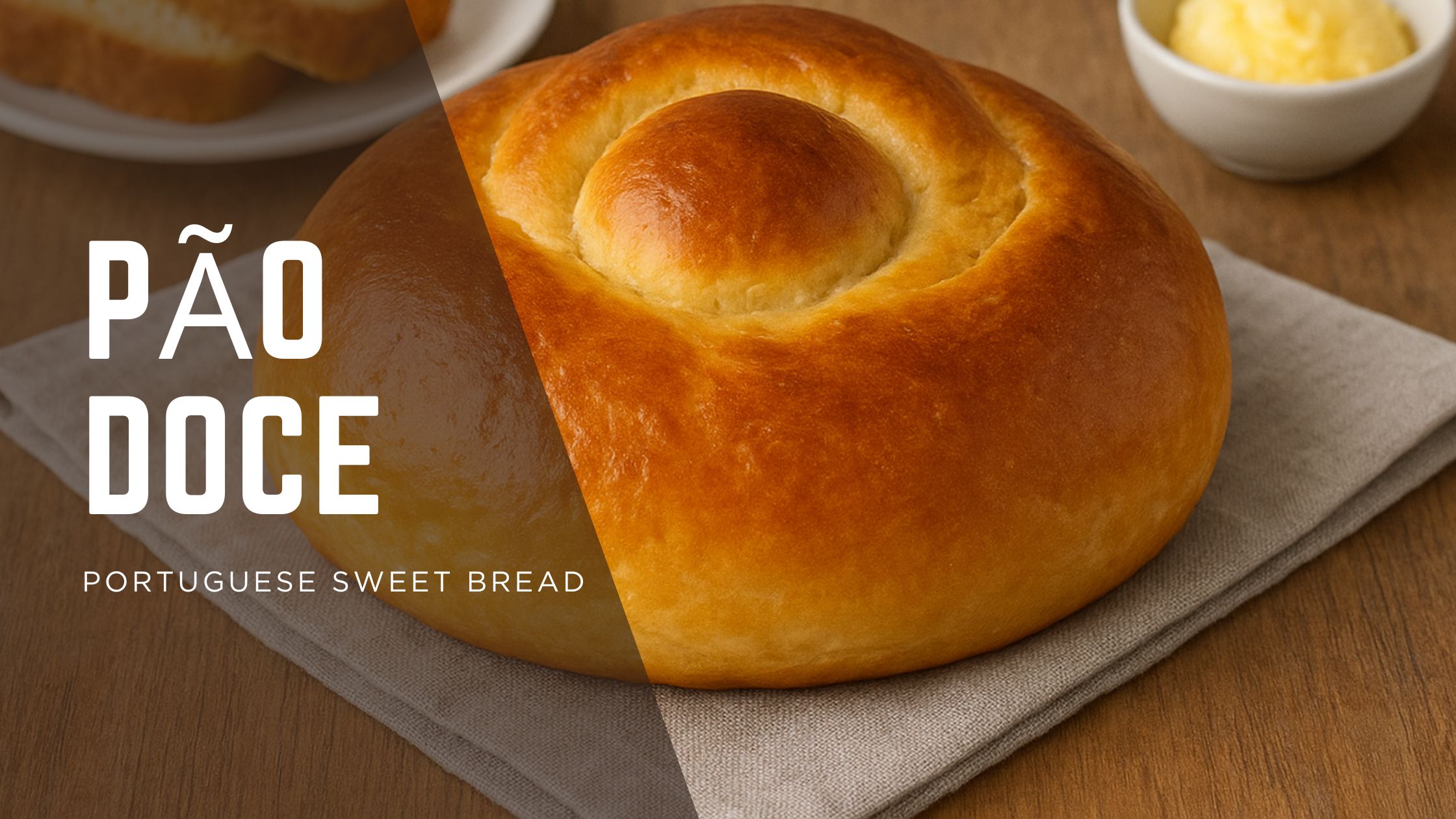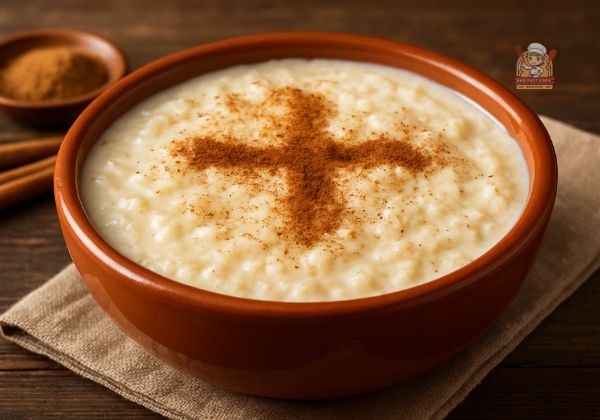If you’ve ever strolled through a Portuguese bakery, you’ve likely been captivated by the comforting aroma of Portuguese Sweet Bread—known locally as Pão Doce. Soft, slightly sweet, and golden brown, this traditional Portuguese bread recipe has been passed down through generations. It’s often served during holidays like Easter and Christmas, but it’s so irresistible that many families enjoy it year-round.
Whether you’re searching for an authentic Portuguese dessert, a festive bread for your holiday table, or simply want to learn how to make sweet bread at home, this recipe will guide you step by step.
What is Portuguese Sweet Bread?
Portuguese Sweet Bread, or Massa Sovada, is a slightly sweet, fluffy bread enriched with eggs, sugar, and milk. Unlike typical sandwich bread, it has a tender, cake-like texture and a subtle citrus aroma. Traditionally, this bread symbolizes celebration and togetherness, often baked in round loaves or braided shapes.
It’s delicious on its own, toasted with butter, or even used as the base for French toast.
Ingredients for Portuguese Sweet Bread
Here’s what you’ll need to prepare this traditional Portuguese bread recipe:
- 4 cups all-purpose flour (plus extra for kneading)
- ½ cup sugar
- 1 packet (2 ¼ tsp) active dry yeast
- ½ cup warm milk (110°F / 43°C)
- ¼ cup unsalted butter, melted
- 3 large eggs (room temperature)
- ½ tsp salt
- 1 tsp vanilla extract
- 1 tsp lemon zest (or orange zest for variation)
- 1 egg (beaten, for egg wash)
Step-by-Step Instructions
Follow these simple steps to make homemade Portuguese sweet bread:
1. Activate the Yeast
In a small bowl, dissolve the yeast and 1 tablespoon of sugar in warm milk. Let it sit for about 5–10 minutes until foamy.
2. Mix the Dough
In a large mixing bowl, combine flour, remaining sugar, and salt. Add eggs, melted butter, vanilla, and citrus zest. Pour in the activated yeast mixture. Stir until a soft dough forms.
3. Knead the Dough
Transfer the dough onto a lightly floured surface. Knead for 8–10 minutes until smooth and elastic. If the dough feels sticky, sprinkle in a little extra flour.
4. First Rise
Place the dough in a greased bowl, cover with a clean cloth, and let it rise in a warm place for 1–2 hours, or until it doubles in size.
5. Shape the Loaf
Punch down the risen dough and shape it into a round loaf (or braid it for a festive look). Place it on a lined baking sheet.
6. Second Rise
Cover again and let the dough rise for another 45 minutes.
7. Bake the Bread
Preheat your oven to 350°F (175°C). Brush the dough with the beaten egg wash to give it a shiny, golden crust. Bake for 30–35 minutes, or until the bread sounds hollow when tapped.
8. Cool and Enjoy
Allow the bread to cool slightly before slicing. Serve warm or at room temperature.
Serving Suggestions
- Breakfast treat: Toast slices and spread with butter or jam.
- Holiday table: Pair with ham, cheese, or sweet spreads for festive gatherings.
- French toast base: Its soft texture makes it perfect for rich and fluffy French toast.
Variations of Portuguese Sweet Bread
- Easter Version (Folar de Páscoa): Traditionally baked with whole eggs (in shells) nestled on top.
- Orange Sweet Bread: Replace lemon zest with orange zest for a citrus twist.
- Coconut Topping: Sprinkle shredded coconut on top before baking for extra flavor.
Tips for Success
- Make sure your yeast is fresh; inactive yeast will prevent your dough from rising.
- For a softer loaf, avoid adding too much flour during kneading.
- If your kitchen is cool, let the dough rise in a slightly warmed oven (turned off) to speed up fermentation.
Final Thoughts
This Portuguese Sweet Bread recipe is more than just food—it’s a tradition that brings warmth, celebration, and family together. Once you bake this bread at home, you’ll understand why it’s cherished in Portuguese culture and beyond.
Whether you’re adding it to your collection of Portuguese desserts, preparing it for a holiday feast, or simply enjoying it with a cup of coffee, this bread is guaranteed to become a favorite in your kitchen.
Frequently Asked Questions (FAQs)
1. What is Portuguese Sweet Bread made of?
Portuguese Sweet Bread (Pão Doce) is made with simple ingredients—flour, eggs, milk, sugar, butter, yeast, and a touch of citrus zest. These create a soft, slightly sweet, and fluffy loaf.
2. Is Portuguese Sweet Bread the same as Hawaiian bread?
They are very similar! In fact, Hawaiian sweet bread was inspired by Portuguese immigrants who brought this recipe to Hawaii. Hawaiian bread tends to be a little sweeter, but the texture and flavor are almost identical.
3. How long does Portuguese Sweet Bread stay fresh?
When stored in an airtight container at room temperature, it stays fresh for about 3–4 days. For longer storage, wrap tightly and freeze for up to 2 months.
4. Can I make Portuguese Sweet Bread without eggs?
Yes, you can substitute eggs with a plant-based alternative like flaxseed “eggs” or applesauce. However, eggs are key to the traditional texture and flavor, so the result may be slightly different.
5. What makes Portuguese Sweet Bread different from regular bread?
Unlike regular sandwich bread, Portuguese Sweet Bread is enriched with eggs, sugar, and butter, giving it a tender, cake-like texture and a lightly sweet flavor.
6. Can I use a bread machine to make Portuguese Sweet Bread?
Yes! You can prepare the dough in a bread machine on the “dough cycle” and then shape and bake it in the oven for that authentic golden crust.
7. What can I serve with Portuguese Sweet Bread?
It’s delicious on its own, but you can enjoy it toasted with butter or jam, serve it with coffee or tea, or use it to make French toast for a rich breakfast.



